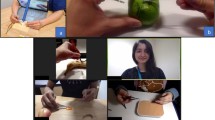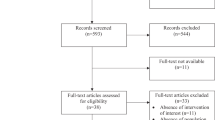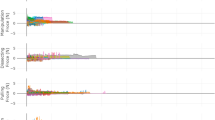Abstract
The animal research community comprises members from a wide variety of backgrounds, some of whom must learn basic surgical skills. Though demand for animal research personnel who have surgical skills is increasing, surgical training opportunities are becoming more scarce. Electronic learning or e-learning platforms can be used as an adjunct to hands-on surgical training. Course developers can adapt these e-learning courses to fit the needs of participants who have varying levels of expertise. The authors outline the steps involved in developing an effective e-learning surgical course. They also describe how to use various equipment and software products to help implement e-learning courses. Though the authors focus on developing surgical courses, course developers could apply the general steps outlined by the authors when developing any e-learning course.
This is a preview of subscription content, access via your institution
Access options
Subscribe to this journal
We are sorry, but there is no personal subscription option available for your country.
Buy this article
- Purchase on Springer Link
- Instant access to full article PDF
Prices may be subject to local taxes which are calculated during checkout

Similar content being viewed by others
References
Gold, J.P. et al. Successful implementation of a novel internet hybrid surgery curriculum: the early phase outcome of thoracic surgery prerequisite curriculum e-learning project. Ann. Surg. 240, 499–507 (2004).
Sieber, J.E. Misconceptions and realities about teaching online. Sci. Engineering Ethics 11, 329–340 (2005).
Baran, S.W., Johnson, E.J. & Kehler, J. A guide for development of effective online surgical training course. ALN Magazine [online]. (2009).
Cook, D.A. & Dupras, D.M. A practical guide to developing effective web-based learning. J. Gen. Intern. Med. 19, 698–707 (2004).
Welsh, E.T., Wanberg, C.R., Brown, K.G. & Simmering, M.J. E-Learning: emerging uses, empirical results and future directions. Int. J. Train. Dev. 7, 245–258 (2003).
Wentling, T.L. et al. e-Learning — A Review of Literature (Knowledge and Learning Systems Group, Chicago, 2000). http://learning.ncsa.uiuc.edu/papers/elearnlit.pdf.
Online Course Development. Office of eLearning and Academic Technologies [online] (2008).
Bernardo, V. et al. Web-based learning in undergraduate medical education: development and assessment of an online course on experimental surgery. Int. J. Med. Inform. 73, 731–742 (2004).
Baran, S.W., Kehler, J. & Johnson, E.J. Laboratory animal science e-learning: an answer for the future. The 3rd Asian Federation of Laboratory Animal Science Associations Congress and the 8th Chinese Association of Laboratory Animal Sciences Annual Meeting. Beijing, China. 28 September 2008.
Allen, B.S., Hoffman, R.P., Kompella, J. & Sticht, T.G. Computer-based mapping for curriculum development. in Proceedings of Selected Research and Development Presentations at the Convention of the Association for Educational Communications and Technology Sponsored by the Research and Theory Division, New Orleans, LA, 13–17 January 1993. [online].
Martin, D.J. Concept mapping as an aid to lesson planning: A longitudinal study. J. Elem. Sci. Educ. 6, 11–30 (1994).
Ertmer, P.A. & Nour, A.Y.M. Teaching basic medical sciences at a distance: strategies for effective teaching and learning in Internet-based courses. J. Vet. Med. Educ. 34, 316–24 (2007).
Baran, S.W., Kehler, J. & Johnson, E.J. Rodent microsurgery web-based learning. 46th Annual Meeting of the German Society of Laboratory Animal Science. Dresden, Germany. 16 September 2008.
Kaufman, H.H., Wiegand, R.L. & Tunick, R.H. Teaching surgeons to operate—principles of psychomotor skills training. Acta Neurochir. 87, 1 (1987).
Rogers, D.A. et al. Peer teaching and computer-assisted learning: an effective combination for surgical skill training? J. Surg. Res. 92, 53–55 (2000).
Minasian-Batmanian, L.C. Guidelines for developing an online learning strategy for your subject. Med Teach. 24, 645–647 (2002).
Koller, C.A., Frankenfield, J.J. & Sarley, C.A. Twelve tips for developing educational multimedia in a community-based teaching hospital. Med. Teach. 22, 7–10 (2000).
Zhu, E., Payette, P. & DeZure, D. An introduction to teaching online. CRLT Occasional Papers 18, 1–5 (2003) [online].
Friedman, R.B. Top ten reasons the World Wide Web may fail to change medical education. Acad. Med. 71, 979–981 (1996).
Dorrian, J. & Wache, D. Introduction of an online approach to flexible learning for on-campus and distance education students: lessons learned and ways forward. Nurse Educ. Today. 29, 157–167 (2009).
Baran, S.W., Kehler, J., Johnson, E.J. & Hankenson, F.C. Development and Implementation of Multimedia Content for Web-based Rodent Microsurgery Courses. American Association of Laboratory Animal Science National Meeting. Indianapolis, IN. 11 November 2008.
Bolliger, D. & Martindale, T. Key factors for determining student satisfaction in online courses. Int. J. E-Learning 3, 61–67 (2004).
Keller, J.M. Using the ARCS motivational process in computer-based instruction and distance education. New Directions Teaching Learning 78, 39–47 (1999).
Hoadley, C.M. & Linn, M.C. Teaching science through online peer discussions: SpeakEasy in the knowledge integration environment. Int. J. Sci, Educ. 22, 839–857 (2000).
Green, M.L. & Ellis, P.J. Impact of an evidence-based medicine curriculum based on adult learning theory. J. Gen. Intern. Med. 12, 742–750 (1997).
Dorsch, J.L., Aiyer, M.K. & Meyer, L.E. Impact of an evidence-based medicine curriculum on medical students' attitudes and skills. J. Med. Libr. Assoc. 92, 397–406 (2004).
Whitson, B.A., Hoang, C.D., Jie, T. & Maddaus, M.A. Technology-enhanced interactive surgical education. J. Surg. Res. 136, 13–18 (2006).
Ridgway, P.F. et al. Surgical e-learning: validation of multimedia web-based lectures. Med. Educ. 41, 168–172 (2007).
Bell, D.S., Fonarow, G.C., Hays, R.D. & Mangione, C.M. Self-study from web-based and printed guideline materials: a randomized, controlled trial among resident physicians. Ann. Intern. Med. 132, 938–946 (2000).
Grundman, J., Wigton, R. & Nickol, D. A controlled trial of an interactive, web-based virtual reality program for teaching physical diagnosis skills to medical students. Acad. Med. 75, S47–S49 (2000).
Ludlow, J.B. & Platin, E. A comparison of Web page and slide/tape for instruction in periapical and panoramic radiographic anatomy. J. Dent. Educ. 64, 269–275 (2000).
Santer, D.M. et al. A comparison of educational interventions. Multimedia textbook, standard lecture, and printed textbook. Arch. Pediatr. Adolesc. Med. 149, 297–302 (1995).
Rosenberg, M.J. E-learning: Strategies for Delivering Knowledge in the Digital Age (McGraw-Hill, New York, 2001).
Bernardo, T.M. & Malinowski, R.P. Progress in the capture, manipulation, and delivery of medical media and its impact on education, clinical care, and research. J. Vet. Med. Educ. 32, 21–30 (2001).
Toohey, S. & Watson, E. Twelve tips on choosing web teaching software. Med. Teach. 23, 552–555 (2001).
Diwakar, V., Ertmer, P.A. & Nour, A.Y. Developing interactive course Web sites for distance education and characteristics of students enrolled in distance learning courses. J. Vet. Med. Educ. 30, 351–357 (2003).
Stepich, D.A. & Ertmer, P.A. Building community as a critical element of online course design. Educ. Technol. 43, 33–43 (2003).
Arbaugh, J.B. How classroom environment and student engagement affect learning in Internet-based MBA courses. Bus. Comm. Q. 63, 9–26 (2000).
Arbaugh, J.B. How instructor immediacy behaviors affect student satisfaction and learning in Web-based courses. Bus. Comm. Q. 64, 42–54 (2001).
Palloff, R.M. & Pratt, K. Building Learning Communities in Cyberspace: Effective Strategies for the Online Classrom (Jossey-Bass, San Francisco, 1999).
Fitzpatrick, M. Learning surgery online in Ireland. JAMA 284, 821 (2000).
Freeman, V.S., Holcomb, D., Brickell, J., Chandler, K. & Muellenberg, P. Faculty members acceptance of Web-based education. Clin. Lab. Sci. 17, 88–94 (2004).
Acknowledgements
J.K. was supported by the SERCA award (#K01 RR019677) from the National Center for Research Resources.
Author information
Authors and Affiliations
Corresponding author
Ethics declarations
Competing interests
S.W.B. and E.J.J. are co-founders of the Veterinary Bioscience Institute, a for-profit company that provides online and mobile on-site surgical and biomethodology training for the LAS community. J.K. is a member of the Veterinary Bioscience Institute's Advisory Board, a volunteer position. M.A.S. has no affiliation with the Veterinary Bioscience Institute.
Rights and permissions
About this article
Cite this article
Baran, S., Johnson, E., Stephens, M. et al. Development of electronic learning courses for surgical training of animal research personnel. Lab Anim 38, 295–304 (2009). https://doi.org/10.1038/laban0909-295
Received:
Accepted:
Issue Date:
DOI: https://doi.org/10.1038/laban0909-295
This article is cited by
-
Knowledge capture and its representation using concept map in bioinspired design
International Journal on Interactive Design and Manufacturing (IJIDeM) (2022)



